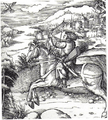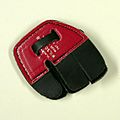Archery facts for kids
Archery is a sport and skill where you use a bow to shoot arrows. The word "archery" comes from the Latin word arcus, which means "bow". Long ago, people used bows and arrows for hunting animals and for fighting in wars. Today, archery is mostly a fun sport and a hobby. Someone who does archery is called an archer or bowman.
Contents
History of Archery
How Archery Started
People have used bows and arrows for a very long time. The oldest signs of bows and arrows are from South Africa, about 72,000 to 60,000 years ago! In Europe, some of the earliest bow and arrow parts were found in Germany, dating back about 17,500 to 18,000 years.
Bows and arrows were also used in ancient Egypt and Nubia. In the Middle East, tools that might have been used to straighten arrow shafts appeared around 10,800–8,300 BC.
Many ancient civilizations, like the Assyrians, Greeks, Persians, and Romans, had many archers in their armies. The Akkadians were the first to use special composite bows in battles. Egyptians even called Nubia "The Land of the Bow" because Nubians were such skilled archers.
Archery was also very important in Asia. In India, the word for archery, dhanurvidya, also meant martial arts. In Korea, the Goguryeo kingdom was famous for its amazing archers.
Archery in the Middle Ages
During the Middle Ages, the shortbow was a main weapon for shooting from a distance. It could shoot about 91 meters (300 feet). Around the 10th century, the crossbow came to Europe. Crossbows could shoot farther and hit targets more accurately. They could even go through armor or kill a horse. But they were much slower to reload than a regular bow.
Later in the Middle Ages, the English army became famous for using many archers with longbows. The French army often used crossbows. Longbows could shoot up to 270 meters (890 feet). They were not super accurate for one person at long range, but when many archers shot together, they were very powerful. Famous battles like the Battle of Crécy and Battle of Agincourt were won thanks to the English longbow.
Archery on Horseback
After horses were tamed, people in Central Asia became amazing at shooting bows while riding horses. These archers wore light armor and could move very fast. They were great at fighting on the wide plains of Central Asia. They used shorter, powerful composite bows that were easier to use on horseback.
These mounted archers helped empires like the Seljuk Turks conquer large areas. They would shoot arrows at enemy soldiers and then quickly ride away before the enemy could get close. Some groups, like the Xiongnu who fought against the Han dynasty in China, were known as "Those Who Draw the Bow" because of their skill.
Why Archery Changed
When firearms (guns) were invented, bows and arrows slowly became less important in wars. Early guns were not as fast to shoot and didn't work well in wet weather. But they could shoot farther and were better for soldiers hiding behind things. Guns also needed less training to use and could go through steel armor without needing a super strong archer.
Because of this, armies with guns had more firepower. Highly trained archers were no longer needed on the battlefield. However, bows and arrows are still effective weapons. Even in the 21st century, archers have been part of military actions. Today, traditional archery is still popular for sport and for hunting in many places.
Archery Becomes a Sport
In the 18th century, archery became a popular hobby again, especially among rich people. The Toxophilite Society was started in London in 1781. Many archery clubs were formed, and they had strict rules and fancy costumes. These events were big social gatherings for the upper class, with flags, music, and even gun salutes for the winners.
The sport was also popular with women. It was often made to look like a Medieval tournament, with winners getting titles and laurel wreaths. Archery was seen as a special British tradition, linked to stories like Robin Hood.
After the Napoleonic Wars, archery became popular with more people. Books like Sir Walter Scott's Ivanhoe (1819), which featured a hero winning an archery tournament, helped make it even more popular.
Modern Archery Sport
In the 1840s, people started to make archery into a modern sport. The first big archery meeting was held in York in 1844. Over time, the fancy traditions were removed, and the rules were standardized. This became known as the 'York Round', where archers shoot at targets from 55, 73, and 91 meters (180, 240, and 300 feet).
Horace A. Ford was a very important archer who improved techniques. He won the Grand National competition 11 times in a row! He also wrote a very helpful guide about archery in 1856.
Towards the end of the 1800s, fewer people played archery as other sports like croquet and tennis became popular. By 1889, there were only about 50 archery clubs left in Britain. But archery was still included in the 1900 Paris Olympics.
In the United States, a group called the National Archery Association was formed in 1879. Later, in the early 1900s, traditional archery saw a comeback. A Native American man named Ishi, the last of the Yahi tribe, shared his traditional archery skills. His doctor, Saxton Pope, helped make these skills popular.
Starting in the 1920s, engineers began to design new types of bows, like the modern recurve bow and compound bow. These modern bows are now the most common in Western archery. Archery returned to the Olympics in 1972. In the 1980s, traditional archery skills were revived and combined with new scientific knowledge.
Archery Equipment
Types of Bows
All bows have a string attached to flexible parts called limbs. These limbs store energy when you pull the string back. Bows can be divided into two main types: those you pull directly and those that use a special mechanism.
Bows you pull directly can be made in different ways:
- Selfbows are made from a single piece of wood.
- Laminated bows are made from layers of different materials.
- Composite bows are made from several materials like wood, horn, and sinew.
Bows also have different shapes when unstrung. A recurve bow has tips that curve away from the archer. A classic longbow is tall and narrow. A flatbow has flat, wide limbs. Some bows, like cable-backed bows, use cords on the back to adjust how strong they are.
In some cultures, like Arab, Turkish, and Japanese archery, arrows are shot from the right side of the bow. In Western archery, a right-handed archer usually shoots from the left side.
Compound bows are special modern bows. They use cams or wheels on the ends of the limbs. This design makes it easier to hold the string back when it's fully drawn. This means the archer can aim longer with less effort. Compound bows are very popular in North America for all kinds of archery.
Bows that use a mechanism to pull the string, like the crossbow, often have a stock (like a gun). Crossbows usually have a shorter draw length but need more force to pull back. They also have devices to hold the string when it's fully drawn. Large crossbows were even used as siege engines in wars.
Arrows and Fletchings
An arrow usually has a shaft, an arrowhead at the front, and fletchings and a nock at the back. Archers often carry arrows in a container called a quiver.
Arrow shafts can be made from wood, bamboo, fiberglass, aluminum, carbon fiber, or other materials.
- Wooden arrows can bend.
- Fiberglass arrows are strong but can break.
- Aluminum arrows were popular because they were straight and light.
- Carbon fiber arrows are very light and fly fast.
- Today, many arrows used in competitions are made from special composite materials.
The arrowhead is the main part that does the work. Some arrows just have a sharpened tip, but most have separate heads made of metal, stone, or other hard materials. Common types include target points, field points, and broadheads (for hunting).
Fletchings are usually made from bird feathers or plastic vanes. They are attached near the back of the arrow. Most arrows have three fletchings, but some have more. The fletchings help the arrow fly straight. One fletching, called the "index fletch" or "cock feather," is usually placed so it points away from the bow.
Fletchings can be cut in different shapes, like parabolic (curved) or shield-shaped. They are often attached at an angle to make the arrow spin in flight, which helps it fly steadily. If fletchings are put on wrong, the arrow's flight path can change a lot.
Bowstring
The Bowstring is the string that connects the limbs of the bow. Modern bowstrings are often made from strong materials like Dacron. Traditional bows might use linen or other natural materials. A good bowstring is very strong for its weight.
Protective Gear
Most archers wear a bracer (also called an arm-guard) on their bow arm. This protects the arm from being hit by the bowstring and stops clothing from getting in the way. Some archers, especially female archers, wear a chestguard to protect their chest.
To protect the fingers that pull the string, archers use a leather tab, a glove, or a thumb ring. A simple leather tab is common. In the Middle Ages, Europeans might have used a full leather glove.
Archers who use the "thumb draw" (common in Asia) protect their thumbs with leather or special rings made of hard materials. Some of these rings are very artistic. In traditional Japanese archery, a special glove with a ridge helps draw the string.
Release Aids
A Release aid is a mechanical tool that helps archers release the arrow smoothly and precisely, especially with compound bows. Most release aids have a trigger that the archer presses with a finger. Some release aids automatically let go of the string when it reaches a certain tension.
Stabilizers
Stabilizers are rods attached to different parts of the bow. They help balance the bow and make it easier to aim. Sights, quivers, and other parts can make one side of the bow heavier, so stabilizers help even out the weight.
Stabilizers also help reduce noise and vibration when the arrow is shot. They absorb energy, making the bow quieter and smoother to shoot. They also make the bow more forgiving of small movements, which helps with accuracy.
How to Shoot an Arrow
Proper Form
When learning archery, it's common to hold the bow based on which eye is dominant. For example, if your right eye is dominant, you would hold the bow with your left hand and pull the string with your right hand. However, some people believe it's better to use your most skilled hand to pull the string, no matter which eye is dominant. You can train your less dominant eye to help with aiming.
The hand that holds the bow is called the bow hand, and that arm is the bow arm. The hand that pulls the string is the drawing hand or string hand.
To shoot an arrow, first stand correctly. Your body should be almost sideways to the target, with your feet about shoulder-width apart. This is called a "neutral stance."
Next, load the arrow. Point the bow towards the ground. Place the arrow on the arrow rest. Attach the back of the arrow to the bowstring using the nock (a small groove on the arrow). This is called "nocking the arrow." If your arrow has three fletchings, make sure the single "cock feather" points away from the bow.
For compound bows, the arrow rest is different, and the cock feather might point up or down.
You hold the bowstring and arrow with three fingers, or with a mechanical release aid. If using fingers, the index finger usually goes above the arrow, and the next two fingers go below. The string is usually held in the first or second joint of the fingers. If using a mechanical release aid, it hooks onto a special loop on the string.
Another way to hold the string, used with traditional bows, is the "thumb release." This is where you use your thumb to pull the string, with your fingers curled around your thumb for support. To release, you open your fingers and relax your thumb. When using this method, the arrow rests on the same side of the bow as your drawing hand.
Then, raise the bow and pull the string back. For recurve bows and longbows, this is often one smooth movement. For compound bows, there might be a slight jerk at the end of the pull, but then it becomes easier to hold the string back.
Pull the string hand towards your face until it rests at a fixed anchor point. This point should be the same every time, usually at the corner of your mouth, on your chin, or near your ear. Hold your bow arm straight out towards the target. Rotate your bow arm elbow so the inside of your elbow is sideways to the ground. This keeps your forearm out of the way of the string.
In modern archery, the archer stands tall, forming a "T" shape with their body. The muscles in your back should do most of the work to pull the arrow to the anchor point. Some modern recurve bows have a "clicker" that makes a sound when you reach the correct draw length.
When you are ready, release the arrow by relaxing the fingers of your drawing hand or by triggering the mechanical release aid. Try to keep your drawing arm still and your bow hand relaxed. Pay attention to how your body moves after the shot, as this can show if your technique needs improving.
Modern Archery Competitions
Types of Competitions
Competitive archery usually means shooting arrows at a target to see how accurate you are. This is done from a set distance or different distances. The most popular type of competition around the world is target archery.
Another popular type, especially in Europe and America, is field archery. This is shot at targets placed at different distances in a wooded area. In the United States, competitive archery is managed by USA Archery.
Para-Archery
Para-archery is a special type of archery for athletes with disabilities. It is controlled by the World Archery Federation and is one of the sports in the Summer Paralympic Games.
There are also other less common and older forms of archery, as well as fun archery games. Flight archery is a competition where the goal is to shoot an arrow the farthest distance possible.
Images for kids
-
Archery competition in June 1983 in Mönchengladbach, West Germany
-
Tibetan archer, 1938
-
Hunting for flying birds from the back of a galloping horse was considered the top category of archery. The favourite hobby of Prince Maximilian, engraved by Dürer
-
Mongol archers during the time of the Mongol conquests used a smaller bow suitable for horse archery. BnF. MS. Supplément Persan 1113. 1430-1434 AD.
-
Snake Indians - testing bows, circa 1837 by Alfred Jacob Miller, the Walters Art Museum
-
Shield cut straight fletching – here the hen feathers are barred red
See also
 In Spanish: Tiro con arco para niños
In Spanish: Tiro con arco para niños

























